I was too curious to hand everything over to the artists
Interview with Jef Cornelis on his film for television, Sonsbeek buiten de perken, 1971, and other films on major art events
Koen Brams & Dirk Pültau
Table of contents
The World Question Center
Balen-Arnhem
False Start
Report on a disillusionment
Aldermen and artists
Technologist's hobby art
1972
Koen Brams/Dirk Pültau: In 1966, you completed your first film about a major art exhibition, the Venice Biennial. Why were you approached for that production?
Jef Cornelis: I still don’t understand it. In those days, documentaries on events like the Venice Biennial were usually done by Ludo Bekkers. Bekkers was a programmer for the Artistic and Educational Broadcasting Service of the Flemish Public Broadcasting Company. He often worked together with Filip Tas, the photographer from Antwerp. Bekkers and Tas were close friends. As for myself, I had just started working at the BRT (Belgian Radio & Television), and in 1964 en 1965, I had mainly done films on historic buildings, such as the Landcommendarij in Alden Biezen (1964), the Park Abbey in Heverlee (1964) and Westerlo Castle (1965).
K.B./D.P.: So you actually had not had any experience with the fine arts?
J.C.: I had been interested in the fine arts ever since I was young. I went to exhibitions and I read about art. Even Venice was familiar territory for me. I had been to the Biennial in 1964, but not at the request of the Flemish public broadcasting network.
K.B./D.P.: Were the films on art events like the Venice Biennial programmed in a specific format?
J.C.: The network had begun broadcasting longer films on art events in the early sixties. The film that I had made on the 1966 Biennial was also broadcast as a separate programme. There were already specific formats back then, such as the Zoeklicht (Searchlight) programme for very short films and Openbaar Kunstbezit (Public Art Collection) for films around ten minutes long.
K.B./D.P.: What impression did the 1966 Venice Biennial make on you?
J.C.: Impression? I thought I had landed in a parish hall. I couldn’t believe my eyes when I saw the Cardinal of Venice handing out the awards. Literally, there was a cardinal handing out prizes to artists! Making the film about the Biennial, however, was an important experience. I think my vision of the art world was already clearly expressed in that film. It is obvious how I feel about the art world: remote, critical, ambiguous – to put it mildly.
K.B./D.P.: How was the collaboration in Venice with Ludo Bekkers?
J.C.: I not only had to work with Ludo Bekkers, but also Karel Geirlandt, then president of the Association for the Municipal Museum of Contemporary Art in Ghent, who was also involved in the BRT programmes on art. I had a different approach to the work than Bekkers and Geirlandt did. I wanted to get rid of those ‘talking heads’ that just sit in front of the camera proffering explanations and interpretations. I remember thinking in San Marco Square in Venice that I never again wanted to work with Bekkers or the other people who were covering that sort of event. I wanted to be my own director, not just passively record something.
K.B./D.P.: Karel Geirlandt did take part in the film on Documenta 4, which you made in 1968.
J.C.: That’s true, but he was almost never on screen. I wanted to make short work of the commentator sitting front and centre.
K.B./D.P.: Was the film on Documenta 4 also intended to be broadcast as a separate programme?
J.C.: Yes, as were several other, longer films about art, such as Drie blinde muizen (Three Blind Mice, 1968), about the art collectors, Becht, Visser and Peeters, The World Question Center (1969), a live broadcast with James Lee Byars, Sonsbeek buiten de perken (Sonsbeek beyond the pale, 1971) and Documenta 5 (1972). In addition, from 1966 onward, but especially from 1970 to 1972, I also made many shorter films for such programmes as Zoeklicht (Searchlight) and Openbaar Kunstbezit (Public Art Collection).
K.B./D.P.: We would like to go into the Sonsbeek film at length, but first a question about the commentator as ‘talking head’. You say that you wanted to get away from that, but in the film on Documenta 4, Jean Leering, the Documenta co-director, gets an enormous amount of camera time.
J.C.: He is on camera a lot, yes, but his visions and ideas are not presented as the one and only gospel truth, which is what commentators always did. In the film on Documenta 4, many different voices are expressed. Notice as well that the film begins with the protest campaign by a group of artists, including Martial Raysse. They, too, get their screen time. The film begins with that.
TOPThe World Question Center
K.B./D.P.: How did you get to know Jean Leering, then director of the Van Abbe Museum?
J.C.: At the time, I visited the Van Abbe Museum regularly, but I didn’t meet Jean Leering until 1968, at the home of the art collectors, Mia and Martin Visser, when we interviewed Visser for Three Blind Mice, a film I made with the art and architectural theorist Geert Bekaert. Three Blind Mice was also the title of the exhibition at the Van Abbe, which Leering had devoted to the Becht, Peeters and Visser collections.
K.B./D.P.: What was that meeting with Leering like?
J.C.: We had started working at the Vissers’ in the morning, and Leering arrived in the afternoon. Leering was in very close contact with Mia and Martin Visser. It was obvious to Geert Bekaert and myself that something very special was happening there, that influential figures visited the Vissers. It was thanks to Martin Visser’s intervention, for example, that Sol LeWitt’s original concepts were produced by a metal company near Bergeyk. Things like that - the originality of the Van Abbe Museum - also partly depended on third parties such as the Vissers.
K.B./D.P.: Three Blind Mice was broadcast on the 18th of June, 1968, the film on Documenta 4 on August 13th, 1968. In 1969 as well, you were almost exclusively committed to the fine arts, with films on Theo van Doesburg, Middelheim 1969, Christo, Marcel Broodthaers and James Lee Byars. In addition to these films, in 1969, you were also involved in the establishment of an alternative art centre in Antwerp, A 379089, whose name came from the building’s telephone number.
J.C.: A 379089 originated in May of 1969, at the Bruges home of the art collector, Hubert Peeters. Kasper König was invited to be coordinator. Isi Fiszman, another art collector, was the most important financier. ‘A’ was set up at number 46 in the Beeldhouwersstraat.
K.B./D.P.: What was your vision with ‘A’?
J.C.: ‘A’ was alternative. We wanted to organize several different projects, and we did: lectures, film viewings, exhibitions, happenings and campaigns…. ‘A’ was not a gallery, and certainly not a museum. One of the events was Marcel Broodthaers’ design of the Musée d'art moderne, Département des Aigles (Museum of Modern Art, Department of Eagles) – the 17th-century section. When the 19th-century section in Brussels closed, visitors continued on by bus to Antwerp, where the Section XVIIe siècle (17th-century section) opened in ‘A’. I filmed both the closing in Brussels and the opening of the Broodthaers’ ‘museum’ for Zoeklicht, including the speeches by Piet van Daalen, then director of the Zeeuws Museum in Middelburg. James Lee Byars was there too. He was walking around with a big hat and a pink scarf over his mouth, dressed up as a bandit.
K.B./D.P.: Why were you so actively engaged with ‘A’?
J.C.: I expect I probably didn’t have too much on my hands at the network at the time. I was also looking for material. The World Question Center, the film that I made in 1969 with James Lee Byars, was no coincidence.
K.B./D.P.: What do you mean?
J.C.: James Lee Byars was showing in the Wide White Space Gallery in Antwerp in the spring of 1969. Geert Bekaert and I made a film about that exhibition for the Flemish broadcasting network.
K.B./D.P.: Was it then that you first spoke to Byars about The World Question Center?
J.C.: I think so. Originally, the idea was to broadcast the film on Byars’ exhibition in the Wide White Space Gallery straight away, but when the plans for The World Question Center were finalized, we decided to broadcast the film on the exhibition immediately before The World Question Center.
K.B./D.P.: In the fall of 1969, Byars did another project in Antwerp, this time in ‘A’.
J.C.: Yes, the performance was This is the Ghost of James Lee Byars Calling. There was a room that was completely painted red. The participants each got a red marker and had to answer questions that were sent on to Los Angeles that very same day.
K.B./D.P.: The project that followed, The World Question Center, was broadcast by the Flemish radio and television programme, and was announced by the weekly magazine HUMO as follows: ‘Based on the questions that have been asked by a great many important people, James Lee Byars is trying to form a picture of present-day society. Approximately 250 letters requesting their cooperation were sent to famous people around the world, including President Nixon, King Feisal, Fellini, Salvador Dali, Jeanne Moreau, Mies Bouwman and so on.’
J.C.: That was Byars’ concept, which we programmed live. That the public network even broadcast this adventure, let alone at 10:00 o’clock on a Friday evening, is still a puzzle to me.
K.B./D.P.: ‘A’ did not last very long. How did that adventure end?
J.C.: That is a very complex tale. A great deal of money was spent in a very short amount of time. The opening party celebrating the landing on the moon, the performance of La Monte Young, Addi Köpcke’s café – they all cost a horrendous amount of money. At a certain point, Kasper König vanished into the sunset. Isi Fiszman decided to give the keys to ‘A’ to Panamarenko. Isi paid the rent, and Panamarenko set up his studio there.
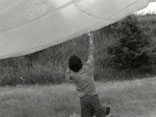
Balen-Arnhem
K.B./D.P.: On February 5, 1970, Panamarenko distributed a pamphlet to announce that he had renamed ‘A’ as the Antwerpse Luchtschipbouw, the Antwerp Airship Building.
J.C.: He worked on the Aeromodeller, his opus magnum, there, which he exhibited at Documenta 5.
K.B./D.P.: You give the Aeromodeller a very prominent place in the film on Sonsbeek buiten de perken. Panamarenko wanted to fly his airship from Balen to Arnhem.
J.C.: Panamarenko intrigued me – the fiction of flying with contraptions he had concocted himself. In the Netherlands, it was taken seriously: he was sent telegrammes saying that he was not permitted to take off. They actually did that.
K.B./D.P.: The filming was done in Balen, at the home of Jef Geys, a week after the opening of Sonsbeek on June 26, 1971. Did Panamarenko really go to Jef Geys’ to fly his Aeromodeller from there?
J.C.: No, he had already moved in with Jef Geys. The Aeromodeller was assembled there.
K.B./D.P.: Isi Fiszman was also at the launch.
J.C.: Of course. Isi always believed in a few selected artists. For him, Panamarenko was beyond all suspicion.
K.B./D.P.: Panamarenko and Isi Fiszman almost immediately put on those white wool suits. Was there actually a screenplay for the whole happening?
J.C.: Those inflammable white suits were made ahead of time. To fly… that’s a boyhood dream, isn’t it… an extension of childhood?
K.B./D.P.: But what was the scenario for the launch? Did Panamarenko actually think he would fly the Aeromodeller?
J.C.: Panamarenko believes something can happen right up to the bitter end, even when it’s never going to. But that is his strength. A really serious conversation with Panamarenko – you should never even try it. He will find a way to avoid it. That was very evident in a broadcast I did with him in 1983. Panamarenko was the central figure in the first live broadcast of the monthly IJsbreker (Icebreaker) programme. He eluded all his other ‘fellow performers’, except perhaps Charles Hirsch, a professor in flow mechanics at the Brussels Free University.
K.B./D.P.: To return to June 26, 1971, as the airship really threatened to lift off, Panamarenko hauled out a pair of scissors and cut open the balloon. The balloon deflates and then there’s a picnic. The entire thing comes across as if it had been a plan agreed on in advance.
J.C.: That was not necessarily the case.
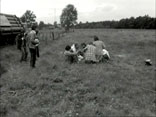
K.B./D.P.: Not only were you and your BRT camera crew present for this event, but so was Joes Odufré, who, on the instructions of the Sonsbeek ‘71 organizing committee, was also making a documentary on Sonsbeek – hence Panamarenko as well. The two films are totally different in their approach. The Aeromodeller is right at the beginning of your Sonsbeek film. Odufré deferred to chronology and edited the Aeromodeller in at the end. The most important difference, however, is that you explicitly put Odufré and his film crew – and Jef Geys, too, who was taking photographs – in your film. Odufré didn’t do that. You showed what was happening as a television event. Have you seen Odufré’s film?
J.C.: No.
K.B./D.P.: The commentator in Odufré’s film reports on the ‘happening’ with, ‘The construction had to endure a great deal – so much perhaps, that at a certain moment, when the airship had almost achieved her complete form, Panamarenko felt it necessary to cut open the balloon with a dramatic gesture, so that all the gas slowly escaped. Perhaps he did it to salvage something of the cabin. Perhaps it was to prevent the flying myth from becoming reality.’ In your documentary, it is even clearer that the flying myth was not something that was allowed to become reality. The camera follows Panamarenko, who walks over to the balloon and laconically calls out, ‘I’ll just cut into her again.’
J.C.: He was not disappointed. If I look back at the images, there is absolutely no possible doubt about that. There was no overall plan. Panamarenko is a maker of objects and the Aeromodeller was a gigantic object. It had a scale that responded to what everybody was doing at the time.
TOPFalse Start
K.B./D.P.: Not only did you put Joes Odufré and his camera crew in the picture, but your film on Sonsbeek ‘71 also began with the announcement of the opening on Dutch television.
J.C.: Those shots were excerpts from the 8 o’clock evening news by the NOS (Netherlands Broadcasting Company). The exhibition opened with a television broadcast on June 18, 1971. First, the exhibition was described, then the newsreader said, ‘…and the Sonsbeek buiten de perken exhibition will begin five seconds from now ….’ The opening ceremony literally took place on television. I thought it was ridiculous, although perhaps we actually didn’t do any better.
K.B./D.P.: Did you get the film spot from the NOS?
J.C.: No, I was in Arnhem on the day of the opening and saw the news broadcast. People were sitting in a tent watching television. I thought it was inconceivable. I just pointed the camera at the television screen. You can see that from the way the picture is flickering about. I had no technology available at the time. I had to do it that way.
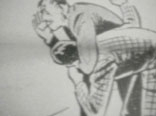
K.B./D.P.: You also show the end of the item that preceded the Sonsbeek announcement, something about a comic strip – it’s not really clear what it’s all about. You could have edited that out. Why didn’t you?
J.C.: That was amusing. I recently noticed that the short film about the opening of Broodthaers’ Département des aigles in ‘A’ begins with a picture of someone’s head. I didn’t edit that out, either. It’s a good image: a man looking into the camera. It’s got nothing to do with Broodthaers’ work, but I didn’t cut it out. I left it in.
K.B./D.P.: It’s a false start.
J.C.: I thought it was droll. I was intrigued by the way the art in Arnhem was being presented, by how serious everybody involved was. I think some people in the Netherlands resented me for that film…
K.B./D.P.: The television medium – in this case the NOS – was the connection for all the various locations. Everything that was ‘out of bounds’ or ‘beyond borders’, everything that had disseminated into space, was connected by television. That rather reminds us of your approach in The World Question Center and your IJsbreker (Icebreaker) broadcast, in which you continually interconnected events and things from different locations. In that first IJsbreker broadcast, for example, in which Panamarenko is the central figure, the parlor of Georges Adé, Panamarenko’s living room and studio, and the direction room of the broadcasting company are all connected together.
J.C.: In the film on Sonsbeek, I simply recorded what was happening. I had to start somewhere. I thought the opening was ridiculous.
K.B./D.P.: You made the film on Sonsbeek buiten de perken together with Georges Adé, with whom you also produced the film on Documenta 5 and countless shorter films. On June 15, 1971, Bert Janssens, director of the television division, gave you permission to produce your documentary on Sonsbeek. When did you actually do the filming in Arnhem?
J.C.: I was there the day of the opening and stayed two more days. By the third and last day of filming, Georges Adé had already left to go back to Belgium.
K.B./D.P.: The film wasn’t broadcast until August 13, 1971, at 10:15 pm. Sonsbeek closed on August 15th. What was the explanation for the delay in the broadcasting?
J.C.: Yes, that’s where you see how things were at the network. I remember that I had been given two days for the editing. I had nothing to say about the broadcasting.
K.B./D.P.: It’s even stranger because, at the beginning of the film, with the NOS news fragment, they were toying with the concept of things being done live.
J.C.: Perhaps the film was only broadcast at a point when a gap needed filling in the schedule. It sounds improbable, but that’s the way it was. In August, there was always surplus broadcast time.
TOPReport on a disillusionment
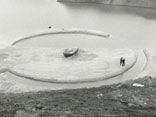
K.B./D.P.: How did you go about putting the film together?
J.C.: Our approach was very thoroughly thought through. We were disillusioned about the project, and we set up a plan of action.
K.B./D.P.: What was disappointing for you?
J.C.: There really wasn’t very much to see at Sonsbeek. The pieces looked lost. The exhibition fell apart. As soon as you left the immediate location, the show was already over. Who would go all the way to Emmen to see the Robert Smithson work, or to Santpoort for the Robert Morris? Just a few pilgrims. There is a problem with that kind of public art… I usually find art in public space dead boring.
K.B./D.P.: But art in public space is not seen as a problem in the film, except at the end, with Daniel Buren.
J.C.: That is true. You could say that art in public space was not yet a theme. There were certainly a few attempts at Sonsbeek, but in fact, it always stayed within the boundaries. Sonsbeek was an event that tried to fill a gap between architecture and art. That is something that has never worked well for me….
K.B./D.P.: And the rest of the activities?
J.C.: That tent where the debates were to be held must have cost a fortune. The result was soporific.
K.B./D.P.: How did the first day of filming progress?
J.C.: First we tried to get some information. We spent several hours with Daniel Buren that day. We also did the filming on the Robert Smithson piece and his interview. I found out that there were concerns about that sculpture, in Emmen where it was located, as well as in Arnhem.
K.B./D.P.: Did you know Smithson?
J.C.: No. I did know Wies Smals, the founder of De Appel. She was a frequent visitor to the Wide White Space in Antwerp and she knew Smithson. We went looking for Smithson and found him when he was still eating breakfast. We offered to drive him to Emmen to see the work and he agreed.
K.B./D.P.: What did you think of Broken Circle, Smithson’s work?
J.C.: What Smithson achieved was something different. It went beyond the sculptural. Smithson’s work was truly a part of the landscape; it changed the landscape. He had been clever enough to seek out an existing quarry. With the sand sprayer and the other sand machines he used, the job was done pretty quickly. And they found the stone that lay in the broken circle at the site.
K.B./D.P.: Smithson himself said, during the interview with Adé while they were walking around the Broken Circle, ‘That boulder was already lying there when I came. It was just lying there.’
J.C.: Yes, I had asked Smithson and Adé to walk around the entire Broken Circle site. Smithson commented on the piece.
K.B./D.P.: There were a lot of Dutch artists exhibiting in Sonsbeek buiten de perken, but they hardly appeared in the broadcast.
J.C.: But they did. Wim T. Schippers, for example. But I had a hard time with that piece.
K.B./D.P.: Stanley Brouwn’s work is not in the film.
J.C.: That is true, but later, I did do a short film on his exhibition at the MTL Gallery in Brussels – in November, 1971.
K.B./D.P.: It is conspicuous that a number of minimal artists, such as Carl Andre, Sol LeWitt and Donald Judd, were not in the broadcast.
J.C.: They were not there in person, any of the three.
K.B./D.P.: The condition, then, for being filmed was that the artists themselves were present?
J.C.: That was obviously our intention.
TOPAldermen and artists
K.B./D.P.: Cor Blok is very manifestly in the picture.
J.C.: I had already heard Cor Blok speak a few times and I thought he spoke very well, better than Wim Beeren. But you have to hand it to Beeren that he had made a very strong selection and was able to motivate many American artists to participate.
K.B./D.P.: Blok gets more camera time than Beeren, although the exhibition was realized under Beeren’s leadership.
J.C.: He was instructed to do it. Blok was the spokesperson and the educator. Beeren has always been a very restless character…, he actually had trouble expressing himself. And from the organizational standpoint, everything went wrong. Robert Morris’ work in Santpoort/Velsen, for instance, was nowhere near finished. It was a huge mess. There was also a lot of tension because they had gone way over the budget.
K.B./D.P.: You brought those problems out into the open in two ways, each time with an interview, first with two aldermen, then with several disgruntled artists. How did you get in touch with the two Arnhem aldermen?
J.C.: We didn’t intentionally seek out the politicians. They were there, and they were complaining. They were not having a very happy time of it.
K.B./D.P.: Georges Adé also posed a very confrontational question. He wanted to know if ‘such an event was a sound investment for a municipality like Arnhem’.
J.C.: That political discussion was something that we were interested in. The aldermen felt very ill at ease.
K.B./D.P.: One alderman said, ‘Of course, it’s especially difficult to come up with new forms after Sonsbeek, after Middelheim. I wonder if these forms … It is, I would have thought, clearly a search for new forms…, whether they appeal to a wider public – and that is my concern as city management – whether it will appeal to the wider public.’ A little later on, he said, ‘I really wonder now if it should have been (financed with) so much money from the city of Arnhem. Experiments are worth doing, but the immediate importance for the people, and that is also our concern as city council – I still have questions about that. I still don’t quite see it.’ Previously, he had said, ‘I have to confess that we didn’t foresee it becoming such an experiment,’ to which the other alderman replied, ‘That experiment cost an incredible amount of money, and the question is whether the public holds it against us or thinks it was a responsible expenditure.’
J.C.: One of them was alderman for financial affairs, the other for cultural affairs. Arnhem had pumped a lot of money into Sonsbeek - much to the chagrin of the local artists.
You also show the end
K.B./D.P.: If you are talking about the artists’ demonstration against Sonsbeek, then the aldermen suddenly started defending it.
J.C.: Yes, they were blowing hot and cold. Let’s just leave it that they felt extremely uncomfortable.
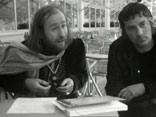
K.B./D.P.: You also put the disgruntled artists on camera.
J.C.: Those artists, from the BBK (Dutch Professional Association of Visual Artists) felt they had been passed over. They were against Sonsbeek becoming international.
K.B./D.P.: One of the artists was talking about a ‘promotion center for the international capitalistic art business’. They also denounced the elitism of Sonsbeek.
J.C.: They saw that they were not getting any attention. Wim Beeren had no intention of doing a cosy project for local artists and art objects.
K.B./D.P.: Georges Adé, for his part, also kept referring to the elitism of the art.
J.C.: Our approach was well thought through. We wanted people to respond to what the artists were doing. There was a slogan that had been stuck onto the Sonsbeek posters: ‘one million elite art’. One million Dutch guilders - that was the Sonsbeek ’71 price tag.
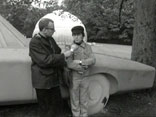
K.B./D.P.: The film ends with an interview with Daniel Buren.
J.C.: Georges and I had already known Buren for a while. We had also made a short film with him, with his exhibition at the Wide White Space in Antwerp (earlier in 1971). Buren had been very clever. He did a piece for the Amsterdam Stedelijk Museum, and his work was in the best spot, in the entrance hall of the museum.
K.B./D.P.: Was it a very deliberate decision to end the film with Buren?
J.C.: Yes. That was not a coincidence.
K.B./D.P.: To wrap up the issue?
J.C.: Yes. You can’t have any doubts. You have to act. It is clear that Georges and I agreed with Buren to some extent.
K.B./D.P.: Georges Adé explicitly invited Buren to formulate his criticism of Sonsbeek and Buren was happy to comply. He claimed that the danger of Sonsbeek was in the suggestion that it was not a museum event: ‘You do not leave the cultural or artistic arena when you exhibit out on the streets or in the fields.’ What he was saying is that you cannot escape the museum.
J.C.: Indeed. If you think you can get away from the museum, then you are naive.
K.B./D.P.: Buren also pointed out that art that was presented on the street or in a field was much more ‘aggressive’, because people came into contact with it when they hadn’t asked for it. While Buren is expanding on this thesis, he disappears from the screen and is replaced with one of his works, which he had made earlier in 1971, in Antwerp, at the Wide White Space Gallery. It is a piece on the outside walls of the gallery, and is therefore in public space, and the camera very explicitly shows the passers-by who hadn’t asked to see his art. Were you doing this to try to put Buren’s statement into perspective?
J.C.: You could interpret it that way.
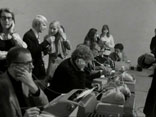
Technologist’s hobby art
K.B./D.P.: The organizers of Sonsbeek buiten de perken wanted specifically to address the subject of communication. As Wim Beeren stated in the catalogue: ‘Therefore we have accepted the fact that the communication media (modern or old) have contributed greatly to our conception of space. And that in addition these media have forged an indestructible link between the time factor and space. A considerable portion of world events comes across to us by those means of communication and nothing else. (…) These communication media have intrigued artists, too, and they are using them in their own very personal ways.’ You also committed yourselves to communication by filming almost no works by artists who were not able to talk to you.
J.C.: I didn’t take that whole thing about communication seriously at all. We were there when Robert Morris exploded in the telephone exchange. He literally said, ‘You can be anywhere in the Netherlands in two or three hours’ time. I think it’s all a bunch of technologist’s hobby art’.
K.B./D.P.: A rather strong reaction.
J.C.: Beeren was crestfallen when he heard that.
K.B./D.P.: In the film, you present all the criticism that was actually there: the criticism from politicians, critics such as Lambert Tegenbosch, the BBK artists, the participants, such as Robert Morris and Daniel Buren. Didn’t that simply affirm the Sonsbeek programme, which hammered on the importance of communication?
J.C.: I had already had my fill of communication. I think I’m objective.
K.B./D.P.: Can you explain that?
J.C.: I see the film on Sonsbeek as a commentary. It is a report. I don’t think that Georges Adé and I tried to manipulate it. I think the film fairly accurately reflects what was happening there. I did not set out to prove myself right. I tried to reproduce the events, as far as they were discernable, in a detached manner. I was not part of them. I did not identify myself or put myself on the side of either the curator or the artist. You can think that is cowardly, but that is who I am. After De langste dag (The longest day), the broadcast on the Chambres d’Amis exhibition (1986), I had Jan Hoet, the Chambres d’Amis curator, on my back. Initiatives are possible, but television must not be overestimated. A television image is just a television image. It disappears while you’re looking at it - if you even see it, because it is rare that anyone has actually seen it. I tried to give everyone the chance to express themselves. It is true that people cannot handle that.
K.B./D.P.: You chose the format for the interviews and you let all the parties have their say. The film also begins with television, with segments of the NOS news broadcast. Doesn’t this confirm Sonsbeek’s ambition of being a communications project?
J.C.: Does it? It is your prerogative to say that.
K.B./D.P.: There is an additional element. In September 1970, Geert Bekaert wrote his first sketch for a broadcast on an urban theme, on ‘the street’ – a broadcast that he wanted to produce with you for the Flemish public network. Referring to the exhibition at the Van Abbe Museum in Eindhoven on the same theme, he literally wrote, ‘The exhibition is not limited to the walls of the museum, but extends to the television network. Conversely, television is involved in a concrete social process (which until now has only happened in the entertainment industry).’ This ambition corresponded perfectly with the plans of the curators of Sonsbeek 71. Yet you say that you did not identify with Sonsbeek’s communications project.
J.C.: No, it did not appeal to me! I did not think it was dealt with seriously in Arnhem. That is my point. I had tried several times to truly work with the medium of television. It was not just a game to me. Whether I was successful or not is another story. It was not appreciated, in any case.
K.B./D.P.: Are you referring to The World Question Center with James Lee Byars?
J.C.: Of course. I wanted to give someone the chance to capture that medium, to take what was happening on and with television into account. I didn’t see much of that happening in Sonsbeek buiten de perken. You have to get yourself into the medium, and you can’t subordinate yourself to the rules of the game. I tried to put that into practice. But it gave me a real headache after The World Question Center, because the central character, James Lee Byars, couldn’t take the pressure. The stress nearly physically destroyed him.
K.B./D.P.: Wim Beeren spoke and wrote not only about communications media, such as television, but his programme had plenty of space for experimental films. Attention was also paid to Gerry Schum’s project, Identifications, which he had begun in July of 1970. It was Schum’s intention to have artists, such as Joseph Beuys, Stanley Brouwn, Daniel Buren, Mario Merz and Lawrence Weiner, create works for television. Identifications actually did premiere on television in Baden-Baden, on November 15, 1970, on the German Südwestfunk (Southwestern Radio and Television). Together with the artists involved, Schum made art for and with television. At the time, there was still enough space in television for people to stop and think about the medium and involve artists in the process.
J.C.: Schum did create works with those artists, it’s true. In my film on Sonsbeek buiten de perken, I was not trying to make television about television.
K.B./D.P.: Is there a connection between your position and Gerry Schum’s?
J.C.: No, I was never advocating what Schum was doing. Schum was at the service of the artist, and that was not what I wanted to do. I felt that I could not take that kind of standpoint.
K.B./D.P.: Yet your work shows the same sensitivity, the idea that something could be done with television.
J.C.: Schum put himself in the artists’ hands. He was truly at the service of the artist. I was never interested in doing that. I was too curious to hand everything over to the artists.
K.B./D.P.: You could say that with The World Question Center, you came closest to Schum’s approach.
J.C.: You could say that.
TOP1972
K.B./D.P.: The film on Documenta 5 was your last full-length film on visual art and the art world of the 1970s. The film was broadcast on July 28, 1972. It would not be until 1985 that you would make another film on visual art. In 1986, you even returned to Arnhem for Sonsbeek ‘86. What happened in 1972?
J.C.: If you watch the film on Sonsbeek ‘71, you can sense that I am slowly getting sick of it – of the art world.
K.B./D.P.: It’s conspicuous that Jean Leering also said farewell to visual art around that same period. In De straat – Vorm van samenleven (The street, a form of living together), the exhibition at the Van Abbe Museum from June 2nd through August 6th, 1972, no fine art was included, although that had been the original idea. Shortly thereafter, he traded the Van Abbe Museum in for the Tropical Museum. No matter how different the reasons may be, it is rather intriguing that working with visual art seems to have become impossible for both you and Leering at approximately the same time.
J.C.: I think that was a coincidence. For me, the fifth Documenta was the decisive moment. The marketing and the spectacle of art hit its first peak there. But I also received other assignments from the Flemish network, on architecture and urbanization, which I accepted with a great deal of enthusiasm.
K.B./D.P.: How was the film on Sonsbeek ‘71 received in the Netherlands? Do you know anything about that?
J.C.: Beeren was not very taken with the film, because the next time I saw him, he was very uncomfortable. There was also a lot of fuss in Belgium. The Belgian art collective ‘Mass Moving’ sent an angry letter to the director of the Flemish network because we had not included their art – a machine that pressed flowers onto the street – in the film. I absolutely did not want that.
K.B./D.P.: To what do you attribute Beeren’s discomfort?
J.C.: People actually only expect applause, and some nice pictures. People do not want you to look at what is really taking place. In the film on Sonsbeek, the artists are much stronger than the organizers. It was the same case with the film on Documenta 5. Harald Szeemann is just the ticket collector. In fact he actually says that himself. The most impressive thing I had seen, both at Sonsbeek buiten de perken and at Documenta 5, were the few artists who had sorted themselves out, who openly admitted that they were doing museum work.
K.B./D.P.: You said that Beeren was uncomfortable at your first meeting after the broadcast of the film, but in 1987, when the Stedelijk Museum, with Wim Beeren as its director, organized the Revision exhibition, dedicated to European television broadcasts on visual arts, several of your films were presented, including the film on Sonsbeek buiten de perken.
J.C.: That is true. Chris Dercon was responsible for the Belgian selection. In addition to the film on Sonsbeek, the Zoeklicht films on Broodthaers, Buren and Brouwn were also shown, and so was The World Question Center. Apparently there were no hard feelings towards me on Beeren’s part.
Transcription: Iris Paschalidis
Documentation: Iris Paschalidis
Editing: Koen Brams
Translation (Dutch to English): Mari Shields
With thanks to argos for the selection of visual material
The Dutch version of this interview was first published in Jong Holland, jaargang 22, nummer 3, 2006.
TOP